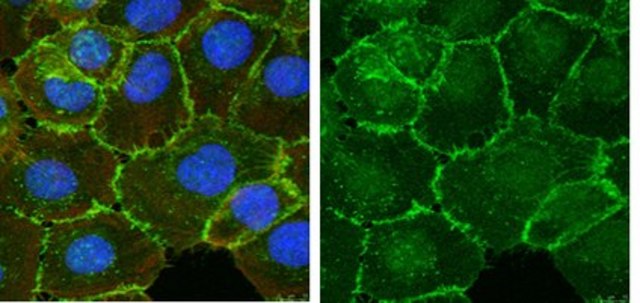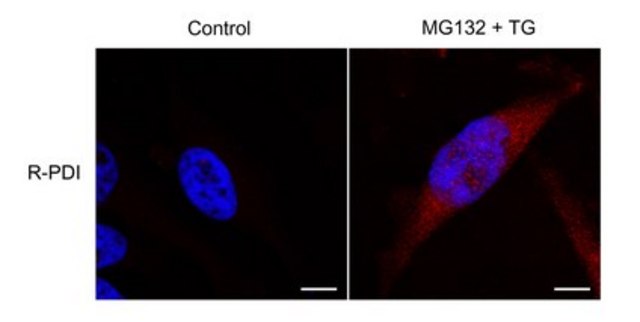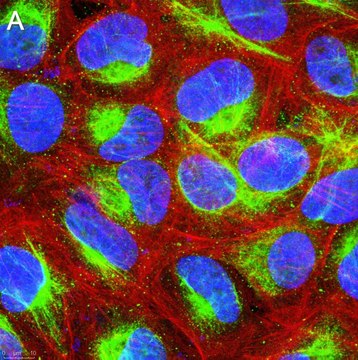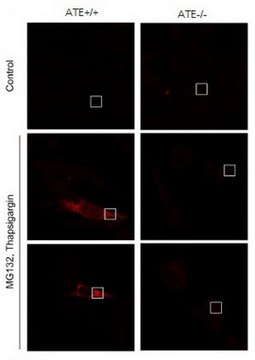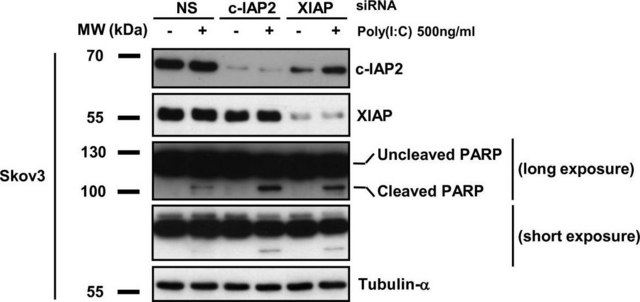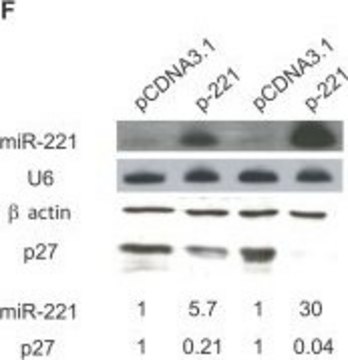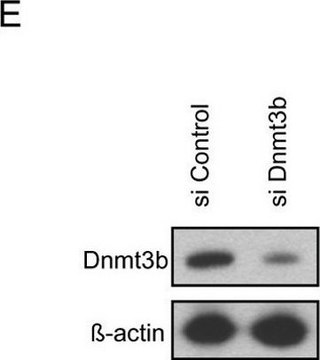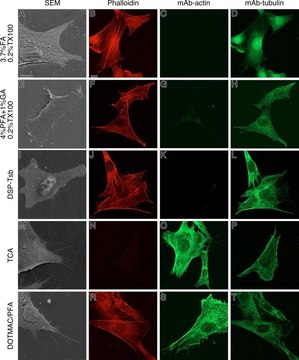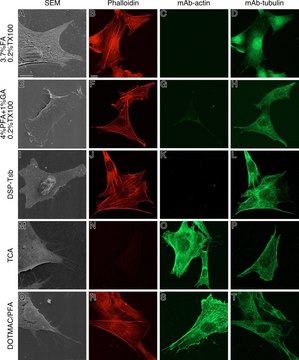ABS1671
Anti-Calreticulin Antibody, arginylated (Nt-Glu18)
from rabbit, purified by affinity chromatography
Sign Into View Organizational & Contract Pricing
All Photos(3)
Synonym(s):
Calreticulin, Nt-Glu18 arginylated, Calregulin, Nt-Glu18 arginylated, CRP55, Nt-Glu18 arginylated, CRT, Nt-Glu18 arginylated, Endoplasmic reticulum resident protein 60, Nt-Glu18 arginylated, ERp60, Nt-Glu18 arginylated, grp60, Nt-Glu18 arginylated, HACBP
UNSPSC Code:
12352203
eCl@ss:
32160702
Recommended Products
biological source
rabbit
Quality Level
antibody form
affinity isolated antibody
antibody product type
primary antibodies
clone
polyclonal
purified by
affinity chromatography
species reactivity
human
technique(s)
ELISA: suitable
immunocytochemistry: suitable
western blot: suitable
NCBI accession no.
UniProt accession no.
shipped in
ambient
target post-translational modification
unmodified
Gene Information
human ... CALR(811)
General description
Calreticulin (UniProt P27797; also known as Calregulin, CRP55, CRT, Endoplasmic reticulum resident protein 60, ERp60, grp60, HACBP) is encoded by the CALR (also known as CRTC) gene (Gene ID 811) in human. Calreticulin (CRT), BiP (GRP78 or heat shock 70 kDa protein 5), and protein disulphide isomerase (PDI) are ER lumen folding factors that, together with other PTM enzymes, assist the process of newly synthesized proteins before their release from ER. CRT, BiP, and PDI themselves are subject to posttranslational signal peptide removal after their synthesis, exposing E18, E19, and D18 at the newly formed N-terminus, respectively. The N-terminus D and E residues of the mature proteins are permissive to arginine-tRNA-protein transferase 1/ATE1-catalyzed arginylation, forming arginylated mature proteins (R-CRT, R-BiP, R-PDI) with altered cellular localization to allow their participation in non-ER functions. Although only the basal levels of R-CRT and R-PDI, but not R-BiP, are generally detectible in non-stimulated cells, upregulated N-terminal arginylation of all three proteins is observed upon cytosolic dsDNA exposure and proteasomal inhibition, indicating a shared role in innate immune responses to invading microbes. In addition, ER stress induction by thapsigargin treatment synergistically boosts proteasomal inhibition-induced upregulation of cellular levels of R-CRT, R-BiP, and R-PDI, suggesting that ER stress accelerates the supply of ER lumenal CRT, BiP, and DPI for N-terminal arginylation.
Specificity
This rabbit polyclonal antibody specifically detected the immunogen peptide, but not the control peptide without arginylation at the N-terminal Glu18 (Cha-Molstad, H., et al. (2015). Nat. Cell Biol. 17(7):917-929).
Immunogen
Epitope: N-terminus
Linear peptide corresponding to the N-terminal sequence of arginylated mature human Calreticulin.
Application
Detect arginylated mature calreticulin using this rabbit polyclonal Anti-Calreticulin, arginylated (Nt-Glu18), Cat. No. ABS1671, validated for use in ELISA, Immunocytochemistry, and Western Blotting.
Immunocytochemistry Analysis: A 1:100 dilution from a representative lot detected Calreticulin Nt-Glu18 arginylation induction in (18-hr 3 µM MG132 and 200 nM thapsigargin) treated HeLa cells (Courtesy of Yong Tae Kwon, Ph.D. , Seoul National University, Korea).
Western Blotting Analysis: 0.2 µg/mL from a representative lot detected Calreticulin Nt-Glu18 arginylation induction in (18-hr 3 µM MG132 and 200 nM thapsigargin) treated HeLa cells (Courtesy of Yong Tae Kwon, Ph.D. , Seoul National University, Korea).
ELISA Analysis: A representative lot detected the immunogen peptide, but not the control peptide without arginylation at the N-terminal Glu18 (Cha-Molstad, H., et al. (2015). Nat. Cell Biol. 17(7):917-929).
Western Blotting Analysis: A representative lot detected Calreticulin Nt-Glu18 arginylation induction upon arginine-tRNA-protein transferase 1 (ATE1) 1A7A isoform overexpression or transfection of various dsDNAs, including poly(dA:dT), in HeLa cells. Combined proteasome inhibition and ER stress induction by an 18-hr 10 µM MG132 and 100 nM thapsigargin treatment synergized the two drugs′ efficacy toward cellular Calreticulin Nt-Glu18 arginylation induction (Cha-Molstad, H., et al. (2015). Nat. Cell Biol. 17(7):917-929).
Western Blotting Analysis: 0.2 µg/mL from a representative lot detected Calreticulin Nt-Glu18 arginylation induction in (18-hr 3 µM MG132 and 200 nM thapsigargin) treated HeLa cells (Courtesy of Yong Tae Kwon, Ph.D. , Seoul National University, Korea).
ELISA Analysis: A representative lot detected the immunogen peptide, but not the control peptide without arginylation at the N-terminal Glu18 (Cha-Molstad, H., et al. (2015). Nat. Cell Biol. 17(7):917-929).
Western Blotting Analysis: A representative lot detected Calreticulin Nt-Glu18 arginylation induction upon arginine-tRNA-protein transferase 1 (ATE1) 1A7A isoform overexpression or transfection of various dsDNAs, including poly(dA:dT), in HeLa cells. Combined proteasome inhibition and ER stress induction by an 18-hr 10 µM MG132 and 100 nM thapsigargin treatment synergized the two drugs′ efficacy toward cellular Calreticulin Nt-Glu18 arginylation induction (Cha-Molstad, H., et al. (2015). Nat. Cell Biol. 17(7):917-929).
Research Category
Signaling
Signaling
Quality
Evaluated by Western Blotting in HEK293 cell lysate.
Western Blotting Analysis: 1 µg/mL of this antibody detected Calreticulin Nt-Glu18 arginylation induction in 7.5 µg of lysate from (17-hr 3 µM MG132 and 200 nM thapsigargin) treated HEK293 cells.
Western Blotting Analysis: 1 µg/mL of this antibody detected Calreticulin Nt-Glu18 arginylation induction in 7.5 µg of lysate from (17-hr 3 µM MG132 and 200 nM thapsigargin) treated HEK293 cells.
Target description
~55 kDa observed. 46.6 kDa calculated. Uncharacterized bands may be observed in some lysate(s).
Physical form
Affinity purified.
Purified rabbit polyclonal antibody in buffer containing PBS with 0.05% sodium azide.
Storage and Stability
Stable for 1 year at 2-8°C from date of receipt.
Other Notes
Concentration: Please refer to lot specific datasheet.
Disclaimer
Unless otherwise stated in our catalog or other company documentation accompanying the product(s), our products are intended for research use only and are not to be used for any other purpose, which includes but is not limited to, unauthorized commercial uses, in vitro diagnostic uses, ex vivo or in vivo therapeutic uses or any type of consumption or application to humans or animals.
recommended
Product No.
Description
Pricing
WGK
WGK 2
Flash Point(F)
Not applicable
Flash Point(C)
Not applicable
Regulatory Information
新产品
Certificates of Analysis (COA)
Search for Certificates of Analysis (COA) by entering the products Lot/Batch Number. Lot and Batch Numbers can be found on a product’s label following the words ‘Lot’ or ‘Batch’.
Already Own This Product?
Find documentation for the products that you have recently purchased in the Document Library.
Our team of scientists has experience in all areas of research including Life Science, Material Science, Chemical Synthesis, Chromatography, Analytical and many others.
Contact Technical Service